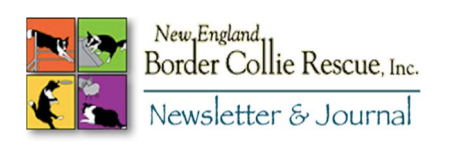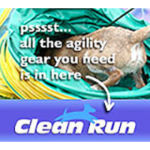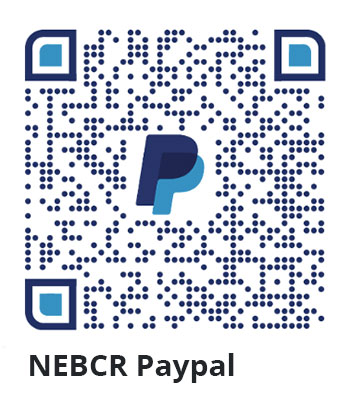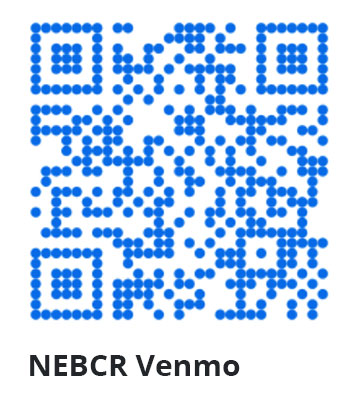Newsletter & Journal 2.6
VOLUME II NUMBER 6
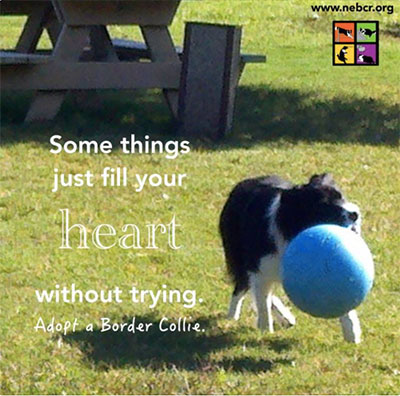
Co-Presidents: Bea Hamm & Sarah Hepburn
Treasurer: Mo Clark
Secretary: Emily Wu
Board of Directors: Monique Fisher, Elise Gouge, Marie Hinds
Website: Rebeca Kerr & Monique Fisher
Editors: Bea Hamm & Rebeca Kerr
Please send your content and pictures to us at: nebcrnewsletter@gmail.com
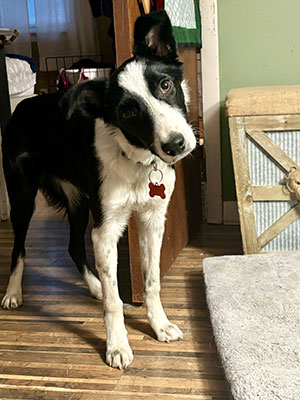
Featured: Letty
Letty needs that special someone to call her own, is it you?
You’ll find her full bio here.
NEBCR would like to thank everyone for making our last Wall of Love fundraiser a huge success bringing in more than our goal. Yay!
We have a new Wall of Love fundraiser we are kicking off today to celebrate 2025 marking 25 years in rescue.
We would like to give you the opportunity to honor a past or present adoptee while providing much needed funds for the dogs headed our way this year. We couldn’t do this without all of you standing behind us.
Reunion celebrating 25 years
Spring is in the air and NEBCR is busy planning the NEBCR Reunion celebrating our 25th year in rescue. Our gracious hosts Craig and Kathy Chittenden have offered up their gorgeous farm again this year. It is located in the hills of Stephentown, NY being held on Aug. 9th with camping available the 8th & 9th (showers and restrooms also available). Two separate fenced in areas allowing reactive dogs exercise as well.
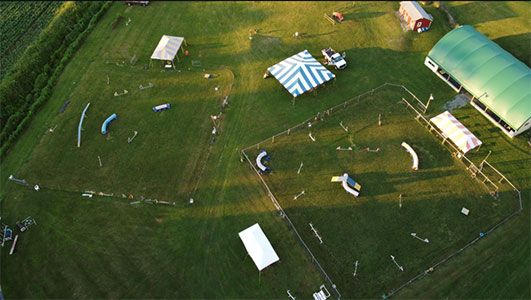
At reunions in the past we have offered grooming, agility, speedway, scent work, disc and various demos. We always have a huge raffle that brings in much needed funds and serve lunch straight from the grill. We are in hopes this year will be our biggest being our 25th. If you are a past or present volunteer or adopter please come join us in our celebration. As we hone in on the details of the day we will update.
Anyone that has come before knows how much fun it is spending the day with old friends or making new ones. Putting faces to the names we only see in posts, meeting the rescues in person or getting reacquainted. If you haven’t come before what are you waiting for?
I have Aug. 8th marked on my calendar and won’t let anything else push it aside. The 25th Reunion what could be more important. Border Collies, fun, Border Collies, huge raffle, Border Collies, demos, Border Collies, food and Border Collie people that can tell stories all day long. What’s not to love?
* Note: This event is not open to the general public, you must be a former or present NEBCR adopter or volunteer to attend.
Introducing NEBCR member Maria Cole-Sherman
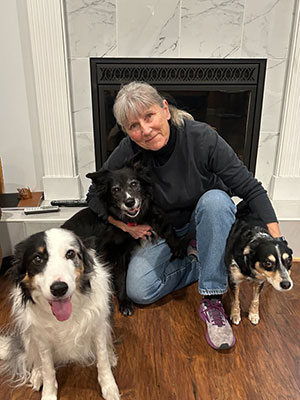
Hi I’m Maria and live in upstate NY with my husband and three rescues. I’m retired now enjoying biking, running and life in general. My career started working part time as an outreach worker, for Washington County Office For the Aging. When I left there I worked part time at Borador Animal Hospital for a few years, until I purchased a Curves franchise, and retired after 5 years of the Curves ownership.
I first learned of NEBCR through Amy Hershberger, long time volunteer. We were all living in Salem at the time, and I would see Amy and her dad out walking her foster pups. We always loved seeing Bain walking Roosevelt! At that time we had two rescues of our own. After our rescues passed, I contacted Amy and she chose us to adopt Rosie. Shortly after, we felt it would be great for Rosie to have a doggie companion and we adopted from Amy again, ACDRA Brieze. Brieze taught fearful Rosie how to play and have fun.
Just over a year later, Amy asked if I would foster NEBCR Seven. I was nervous at first, yet Seven was such an easy foster and we loved her from day one. And as they say, the rest is history! We have had several fosters in recent years, some for short stays, some for longer stays, and we have our foster fail, beautiful Dottie. While I had kind of decided to no longer foster, due to some changes in life, we then decided…one more. A couple of weeks ago on a Tuesday evening, I said to my husband, I want another girl, just one more. The very next morning I got a call from Bea. She needed a home for 16 yr old Bessie. Bessie arrived a few days later, and we love her beyond measure. Every NEBCR foster has brought love and happiness to our home, along with moments of chaos, but the best possible chaos. And it has been a privilege to help every foster in whatever little way we could. And Brieze is still showing all the fosters how things are done here. Thank you for trusting us with so many beautiful fosters.
So, You Think You Want a Border Collie?
by Kerry Maloney
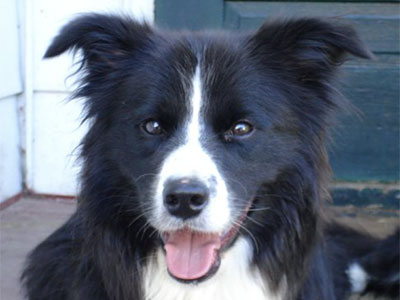
As I sit here writing this, listening to the nonstop wind howling by my house, I am desperately looking forward to the warmer days of spring that I hope are coming soon. I am even looking forward to mowing my lawn again, one of my least favorite yardwork chores. Whenever I am outside, puttering around in my yard, I have my dogs out with me. I was always amused with my previous dogs’ reaction to the lawnmower.
Dublin never really trusted the loud push mower, so spent the entire time I was mowing watching it from a safe distance, ideally from behind a tree or the shed. Limerick, who never quite recovered from the Great Frisbee Mishap of 2010, would worriedly pace around the yard with his beloved replacement frisbee clamped tightly in his mouth, lest the lawn mower attack another unsuspecting, beloved frisbee of his. Casey would run about 15 feet in front of me and drop his ball in the path of the mower, then stand back and wait for me to kick it out of the way, thereby forcing me into a game of fetch. I appreciated his ingenuity.
Belle has been a challenge. She is incredibly smart and is convinced that if I am outside, it must me because I want to play fetch. (In her defense, I am usually there to throw the frisbee for her). When I had my back deck built, I briefly had the fantasy of sitting on my deck in the sun, enjoying the weather and my morning coffee…which sort of happened, but with the addition of a frisbee being tossed at me by a rather impatient Belle. I have a hammock chair, and Belle was convinced the best place to place the frisbee was directly under my chair. Which, to her credit, was actually the closest she could place it to me, but it was also impossible for me to actually reach it there without getting out of my chair. I decided to fix this by placing a small table next to my hammock and training her to place the frisbee on that instead. Problem solved!
Now when I first started teaching dog training, one of the most useful pieces of advice my mentor gave me was “make sure what you think you are teaching the dog is what they are learning”. I didn’t quite know what she meant, and she explained it through this example. She asked if my dog knew what “sit” meant. I responded, “of course he does. “She asked what I thought it meant, and I said to stop what he is doing and place his butt on the floor. She said “ok, turn your back on your dog and tell him to sit.” I did and Dublin stopped what he was doing, walked around to look at me, then sat at my side. This was a simple, yet effective, way of teaching me that while I thought my dog knew “sit” was to place their butt on the ground immediately, my dog thought it meant to come to me, make eye contact and then sit at my side. Ok, what’s the big deal? In this case, it wasn’t a problem, but it was a good lesson to keep in mind (and one I forgot with Belle).
I thought I had taught her that when we were on the deck and I was in my chair, she was to place the frisbee on the side table. What she apparently learned was placing the frisbee on any flat(ish) surface was the way to activate the fetch behavior in humans. So, she would randomly toss a toy up onto the game table at my friend’s house or would jump up and stick the frisbee on the counter when we were inside. All new behaviors that started immediately following the deck/table training.
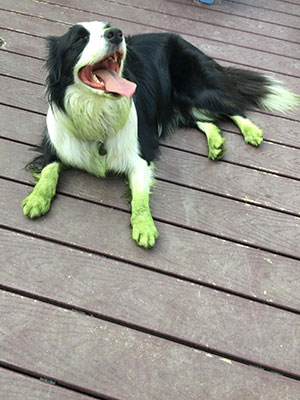
The most concerning and unexpected twist this took was when I first mowed the lawn that spring. Belle looked at the small mower being pushed around the yard by me and saw a small, mobile table and thought “challenge accepted!” and ran up and placed the frisbee on to the top of the mower. And just like that, Danger Fetch was born! This was clearly not something I wanted to continue for obvious reasons.
I tried to address it in a variety of ways. I brought her inside and crated her while I finished mowing. Belle, who was crate trained and normally a fairly calm (for a border collie) and relaxed dog, was a frothing mess by the time I came back inside. That’s when I realized that I had never been in the backyard without her being out there with me – and this was apparently an unbreakable rule in her mind. I tried training it. I would leave treats or her food in with her while I went out to mow, but she was too stressed to eat. I tried leaving her in the house but not crated, which only ended up with a stressed out and frothing Belle at the window instead. I didn’t want her to be constantly stressed out, so next, I tried to train outside. As Belle was calmer when she was outside with me, she was more able to handle learning a new behavior. I worked on a variety of modified behaviors, changing my approach depending on what worked and what didn’t. In the end, Belle and I reached a compromise. She stays about 10 feet from the mower at all times (which keeps her safe and keeps my stress levels down) and I will toss the frisbee for her. She knows that if she comes any closer than the 10 feet, the mower turns off and I turn into an unresponsive statue until she moves back out 10 feet. She has gotten freakishly good at tossing the frisbee onto the top of the moving lawnmower from 10 feet away, which wasn’t where I thought this training would end up, but it is something I can live with – and surprisingly, I have yet to mow over a frisbee in the last 3 years this has been our routine. It does take me twice as long to mow the lawn than if I just crated her but at least this way, Belle is happy and unstressed and I am happy she is safe.
Could I have spent a lot more time and trained a different behavior? Probably. In the end, you need to do what works for you and keeps your dog safe. I think of training border collies as a dance of sorts, working together to figure out each others’ quirks and requirements. I don’t want a mindlessly obedient dog – I want one who uses their brain to figure out the situation. Sometimes this goes awry (remember the feathers??) but in the end, you train what works best for your situation.
Follow your heart… experience the rewards for yourself. If you want to give a deserving dog their second chance at life visit NEBCR.org to read about what fostering entails and to fill out a foster home application.
Dog Sports?! Try ’em and see what sticks
By Sara Saperstein
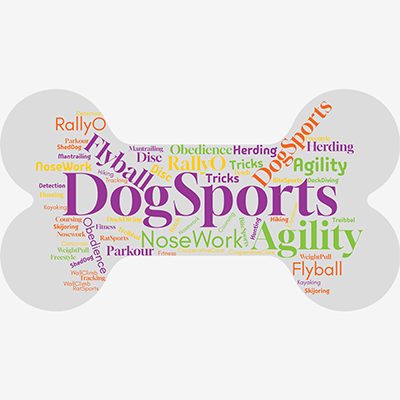
Many of us want to do more with our dogs. While the number of dog sports available has increased, in some ways it has become more difficult to determine which sport is right for you and your furry companion. I’ve tried over a dozen dog sports in order to find out what I and my border collie like best. Here I hope to summarize what I’ve learned to help you find your own dog sport journey.
But first: why do dog sports? Many people have fun training tricks at home with no need to participate in formal sports, but training to a third party standard can motivate more focused training sessions with more robust results. On one hand they push you to strengthen both your and your dog’s skills by working on distance, duration, and distraction to proof the behaviors for competition. And on the other hand they give you a roadmap of complex skills to train. I have a hard enough time picking what I want to make for dinner each night, let alone what I want to train my dog day after day. Having sport goals to work towards keeps the training fresh and the training plan more clear.
In addition to focusing your training, another great reason to participate in dog sports is the sense of community. Seeing likeminded individuals every week in class or spending all day at trials with the same group of people is a wonderful way to make friends and build lasting connections. You can get together with local training friends on weekends, share training ideas and troubleshoot challenges in online communities, and volunteer at trials to further your connection. And I would be remiss if I didn’t mention that a lot of people love getting ribbons and certificates from competing and trialing!
We’re fortunate here in the northeast to have a vibrant and friendly dog sport community with many choices of where to train and what sports to choose. To get connected with dog sports local to you, look at what sport classes are being taught by dog trainers in your area, search AKC and other dog sport organizations (see below) for upcoming competitions or trials near you, or ask in the NEBCR Adopters group on Facebook. Some dog training facilities offer Try-It classes that feature a number of different sports. Typically these include rally obedience, nose work, agility, and trick training. You may also sometimes find workshops for dock diving, disc, or ratting.
There are many organizations that hold dog sport competitions available in the north east. When I was starting out I had a difficult time understanding where to go for more information.
Here is a list of some of these organizations, grouped by sport:
- Multisport: – American Kennel Club (AKC), Dog Scouts of America (DSA), Gameness Relationship Control (GRC), Fenzi Dog Sport Academy (FDSA, online titles)
- Trick: AKC, Do More With Your Dog (DMWYD)
- Nose work: National Association of Canine Scent Work (NACSW), Performance Scent Dogs (PSD), United States Canine Scent Sports (USCSS)
- Dock diving: North American Diving Dogs (NADD), Ultimate Air Dogs (UAD), International Dog Sports (IDS)
- Agility: United States Dog Agility Association (USDAA), North American Dog Agility Council (NADAC), United United Kennel Club (UKC), American Kennel Club (AKC)
- Flyball: North American Flyball Association (NAFA), United Flyball League International (UFLI)
- Herding: United States Border Collie Handlers Association (USBCHA), American Herding Breed Association (AHBA), AKC
You may have heard that only purebred dogs with papers may compete in AKC, but in fact, the Canine Partners program for mixed breed dogs or the Purebred Alternative Listing (PAL) for unpapered purebred dogs are registries that enable you to compete in many AKC sports. In addition, AKC coordinates with other organizations such as UpDog, NAFA, NADD and more so that your titles in those sports will show up on your dog’s name if you request it. But there are also plenty of organizations outside of AKC, too, so you can go with what is most convenient for where you live. Each organization cultivates its own vibe, so you also have options to find what fits you best. Ask around, try it out, and find what fits you and your dog!
Have more questions?
Do dog sports require a big time commitment?
It can be as much or as little as you like. Some sports are more of a lifestyle, like flyball, but other sports are easy to do casually like dock diving and ratting. If you’re interested in a weekly class some good options are agility and nose work.
Can I do dog sports if my dog is reactive or environmentally sensitive?
Border collies have a reputation for being environmentally sensitive but also very driven. There are definitely options out there for the dogs with big feelings and/or big reactions. If your dog is not human-reactive, nose work is an excellent option. For dogs who struggle with both unfamiliar dogs and unfamiliar people there are multiple online titling options that allow you to progress in your sport such as Fenzi TEAM titles, Do More With Your Dog, AKC tricks, NACSW skills challenges, and North American Canicross, to name just a few.
OK, I still don’t know where to start. What’s the top sport you recommend people start with?
Without hesitation my top recommendation is nose work. Any dog can do it and there are so many benefits to nose work: it’s fun and accessible, provides physical and mental stimulation, builds confidence, doesn’t require a lot of equipment, and is so good for environmentally sensitive dogs. I recommend working with a certified nose work instructor (CNWI) to get started if you can.
Read more about Dog Sports and Jobs here
ASK THE VET: How Pain Affects Behavior
by Dr. Sarah Hepburn
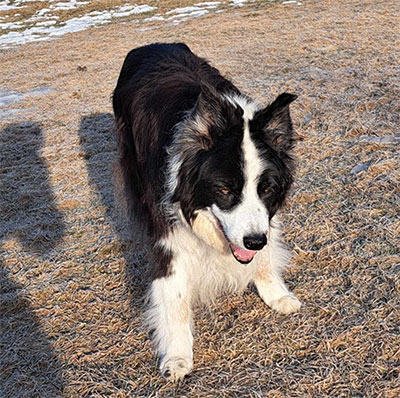
Pain, whether acute or chronic, can alter a dog’s normal behavior in several ways. A once-friendly and social dog may become withdrawn, irritable, or even aggressive. A typically active dog may suddenly appear lethargic, avoiding play or exercise. These changes are not signs of disobedience or aging but rather a response to discomfort.
When a dog is in pain, their body is in a state of stress. Pain triggers the release of stress hormones, affecting mood, energy levels, and interactions with others. Some dogs may become overly sensitive to touch, reacting defensively when petted or handled. Others may hide, sleep more, or avoid stairs and jumping onto furniture to prevent worsening their discomfort.
Common Signs of Pain-Related Behavior Changes
Dogs exhibit various signs when they are in pain, including:
- Aggression or irritability – Growling, snapping, or avoiding contact when touched in a painful area.
- Lethargy or withdrawal – Decreased interest in play, walks, or social interactions.
- Restlessness – Pacing, difficulty finding a comfortable position, or excessive panting.
- Changes in eating habits – Loss of appetite, slow eating, or difficulty chewing.
- Increased licking or chewing – Focusing on a specific body part, often indicating joint or nerve pain.
Causes of Pain in Dogs
Pain in dogs can stem from various sources, including:
- Arthritis and joint disease – Common in older dogs, causing stiffness and reluctance to move.
- Dental problems – Tooth infections or gum disease can make eating painful.
- Injuries – Sprains, fractures, or wounds may cause limping or sensitivity.
- Internal conditions – Issues like pancreatitis, kidney disease, or cancer can cause chronic pain.
Helping a Dog in Pain
If you notice behavior changes in your dog, consult a veterinarian to determine the underlying cause. Treatment may include medication, physical therapy, dietary changes, or lifestyle adjustments. Pain management is crucial to ensuring a dog’s comfort and well-being. By recognizing pain as a driver of behavior changes, pet owners can provide the care and support their dogs need to live happy, pain-free lives.
TRAINER’S CORNER: Spring Training 101
by Elise Gouge, CPDT, CABC Certified Behavior Consultant & Trainer

Spring is here and with that comes outside adventures, lots of critters popping out, open windows letting new sounds come in and lots of things to distract our dogs. Plugging in some training can make a huge difference with a smooth transition into the new season and having a great summer.
Here are some tips to make this season a super successful one!
Integrate training into daily routines.
One of the big pitfalls in training is thinking that you have to set aside an hour or other chunk of time to get it done. In truth, when you sprinkle obedience into daily routines it translates much better to real life application. This is a great time to implement the Premack Principle. Premack basically means eat your veggies to get dessert or do your homework before you can go out to play. It means do something you’re not crazy about in order to get the thing you really want. Your dog wants to sit on the couch with you? Ask for a sit first. Your dog wants to go outside? Ask for an easy trick. When you implement Premack you’re not trying to train new skills. You’re aiming to have the dog be successful and do easy skills in order to get the thing they want. You want to create the association that when your dog listens to you, wonderful things happen. If you are Premacking things 20 times a day your dog will love listening to you. This means that when you ask your dog to do something when you really mean it, like on off leash recall, your dog will be much more likely to do it since they have a solid foundation of listening equated with lots of good stuff. There’s just one caveat, which takes us to our next tip.
Be consistent.
This is probably the most important and the weakest point for most households. Here’s a prime example. You don’t want your dog pulling on leash. Yet, when you go for a leash walk, you let your dog pull you the last 20 feet when you get back to the house…or when you see his best friend working in the yard…or when you’re approaching the car after a hike…or…you get the point. It doesn’t matter if your human brain has a good reason for letting your dog pull, from the dog’s point of view you sometimes allow pulling and sometimes don’t. There’s a huge issue with that since now you’ve created what’s called a variable reinforcement schedule. This is the same schedule that slot machines and gambling uses. It means that if you keep trying a behavior, at some point you might get rewarded. So, you try harder and harder. In the case of your dog, your dog will keep pulling because if they have been rewarded at some point, there’s hope they could be rewarded again.
Use your words wisely.
To help with consistency, choose your words well and be clear. If your recall word is COME, don’t say it 5 times and throw in c’mere, c’mon let’s go, etc. Say a crisp COME and reward your dog appropriately. If you don’t think your dog will obey, don’t say a command and get blown off. Be proactive and intervene with different words (or no words) so that your commands maintain true meaning. Most dogs don’t know commands as well as we think they do. Think your dog really knows their commands? Try this easy game. Without treats, play a little Simon Says. Simon Says put your hands on top of your head and ask your dog (one time) to sit. Release your dog. Now, Simon Says put your hands on your shoulders and ask your dog to sit. Repeat this with your hands on your hips, knees, and touching your toes. Can your dog reliably sit for each of those five positions? Now we throw a little Dr. Seuss in and say can your dog do it in the house, in the yard, in the driveway, in a field, in a store, can they do it when you say SIT softly, when you say it loud, when you say it abruptly and when you say it proud?
Management is key.
There are so many cool things you can do to help your dog listen and it all starts in the house with good management. If you have a barky dog, adjust your layout so they can’t sit at a window announcing every person or delivery truck that goes by. Use music, fans, AC and other ambient sound to muffle certain sounds. Crate your dog or use baby gates if they jump all over visitors. If they blow you off in the backyard, let them out with a longline attached so you don’t get frustrated trying to get them inside and instead you can simply reel them in like a fish. Many times we get reactive to our dog’s behavior when, really, if we spent the same amount of time being proactive we’d eliminate the unwanted behavior all together!
Use enrichment.
Good management’s best friend is good enrichment. This makes a huge difference for our dogs! Ditch the food bowl and feed your dog via enrichment. Easy options are food scatters inside or out, where your dog has to forage and find their food. What is easier than flinging a cup of kibble around? Stuff a Kong and freeze it. Many times people think of enrichment for treats and extra good stuff and mealtimes become a wasted opportunity. Parse out your dog’s mealtime ration throughout the day via enrichment and training. Additionally, be strategic and use enrichment when your dog is likely to misbehave. For example, if your dog is going to jump on the kids when they get home from school, crating them with a frozen Kong is a win-win for everyone. There’s an amazing website that’s fun to use – www.knowitenrichment.com.
Five simple tips that can absolutely transform your dog from a sloppy listener to a sharp, happy listener. Gaining momentum by doing these things makes everything more fun and, in turn, more likely to continue happening. It’s important to know yourself as well. If you are a person that excels with self-discipline, then sticking to a routine of consistency will be straightforward. If you do better with some system of accountability, take a dog training class to keep training in the forefront of your mind. Make a calendar or checklist and hang it in an obvious place. Just like we reward our dogs for good behavior, make sure to reward yourself too so you stay motivated and invested.
Happy Springtime!
